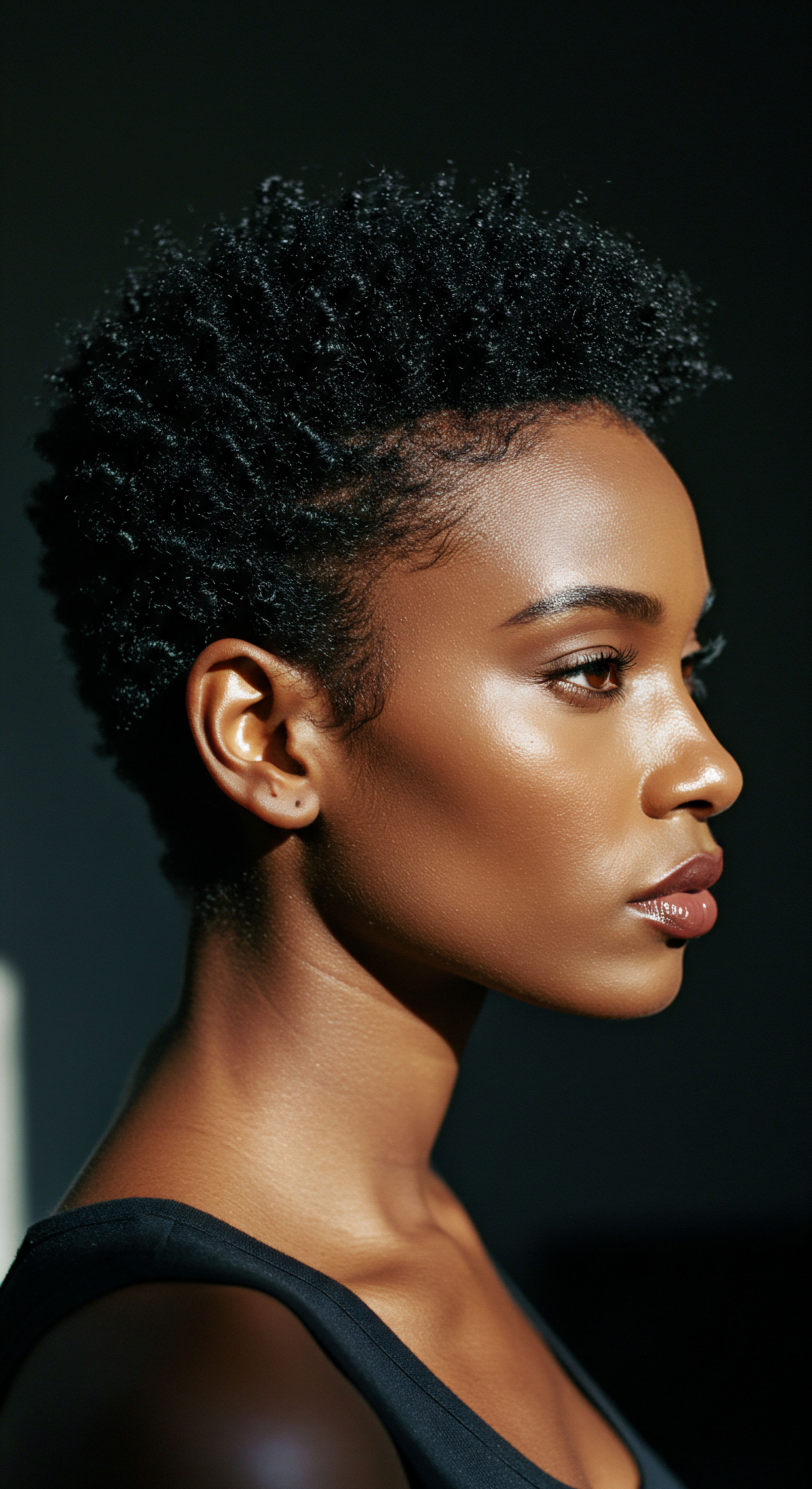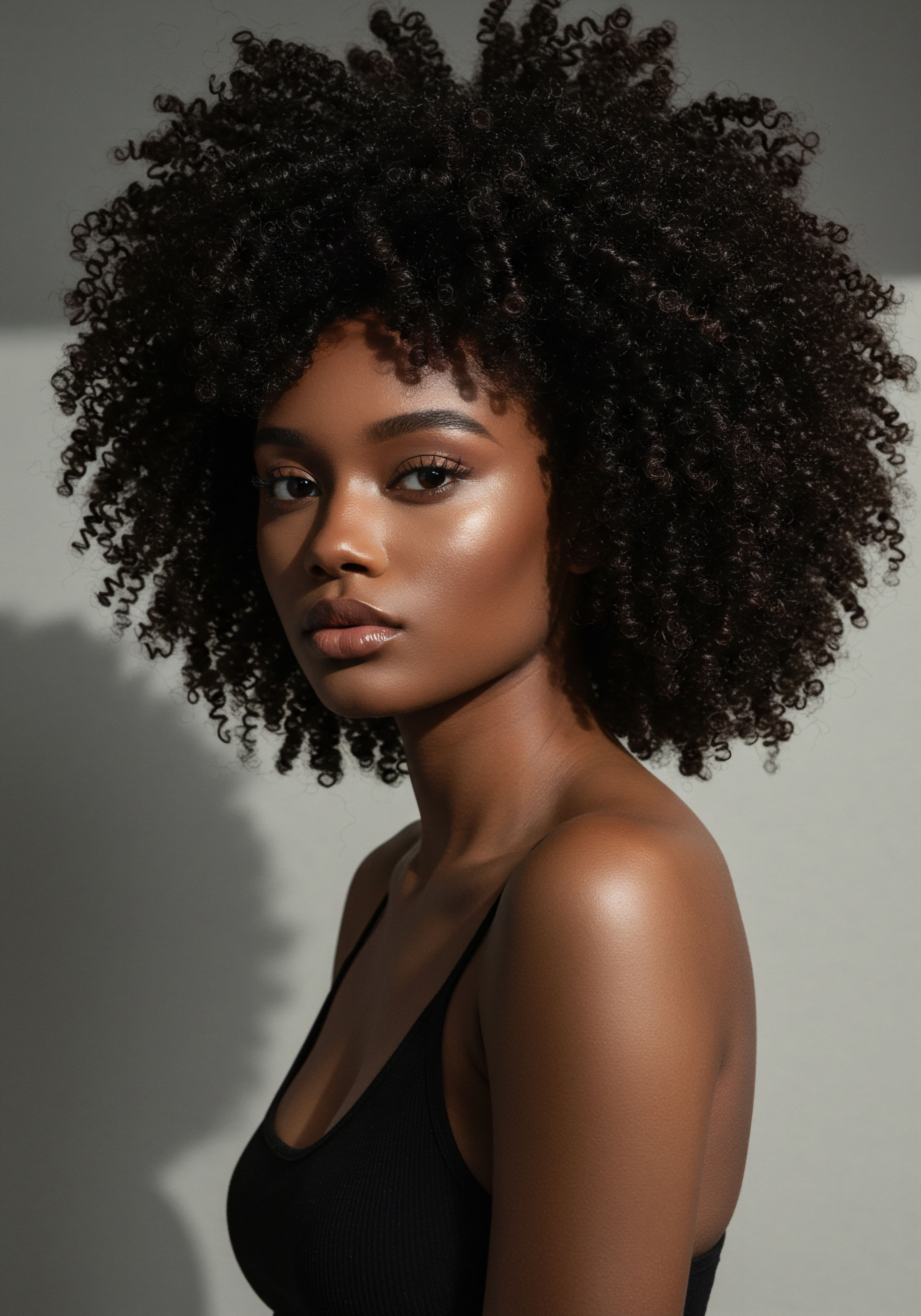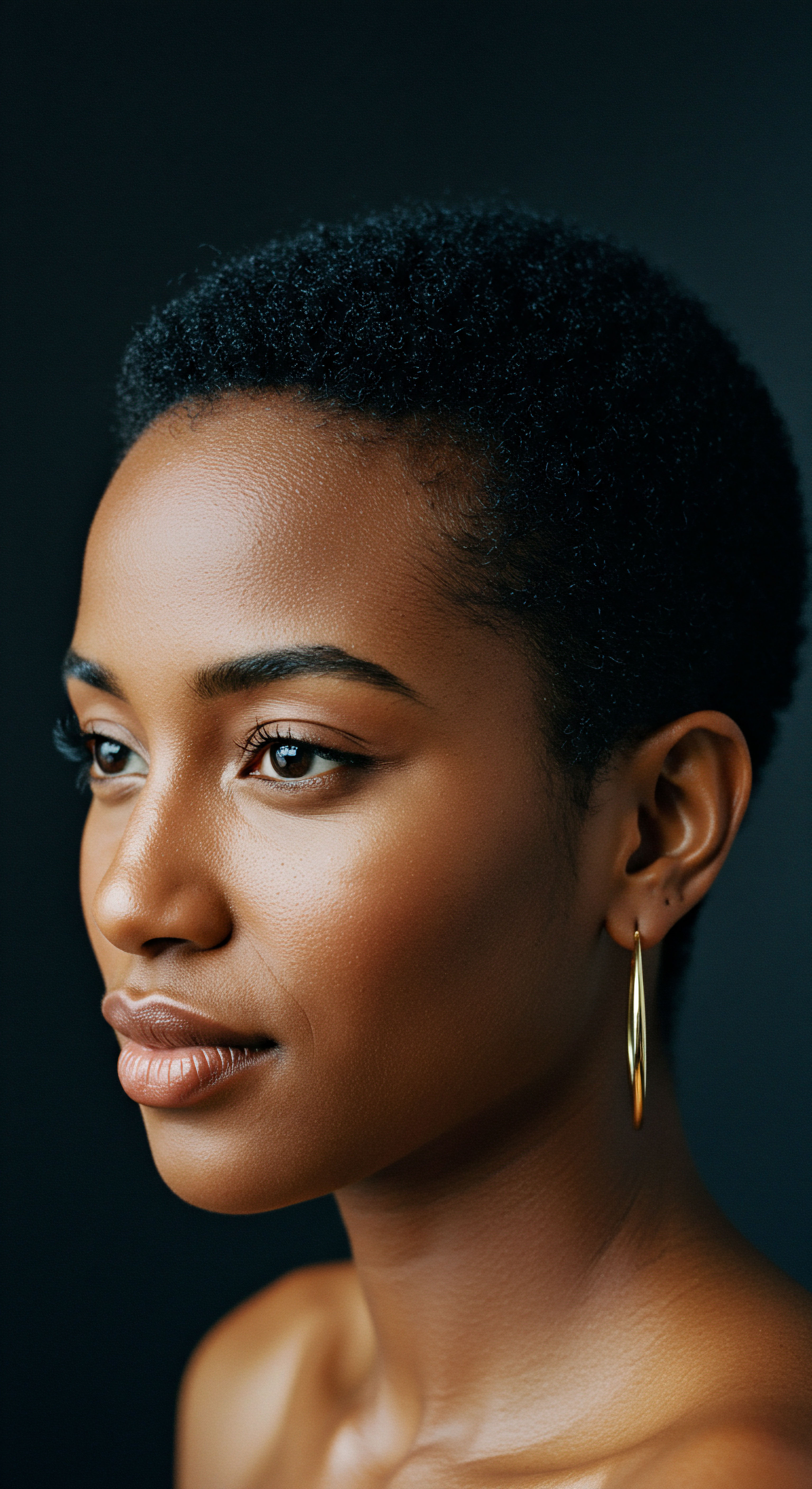
Roots
The quiet hours of night hold a particular power, a time when the world slows and we prepare for restoration. For many, this preparation extends to our hair, a personal crown carrying history, identity, and vulnerability. We often seek modern solutions for nighttime hair care, yet a deep well of wisdom lies in practices passed down through generations. These traditional hair covering customs, far from being mere relics, whisper secrets of protection and preservation, offering profound insights for our contemporary routines.
What can we learn from the ancient gestures of wrapping and shielding, and how do these long-held habits speak to the very structure of our strands? This exploration begins at the foundation, examining the elemental relationship between hair and its nightly repose.

The Enduring Wisdom of Hair Covering
Across diverse cultures and continents, hair has consistently held a place of reverence and significance. It has served as a symbol of status, spirituality, beauty, and even resistance. Consequently, the care and protection of hair became an integral part of daily life, extending into the hours of sleep. Traditional communities, without access to modern laboratories or scientific instruments, observed and understood the effects of friction, moisture loss, and environmental stressors on hair.
Their solutions were often practical, ingenious, and deeply woven into their cultural fabric. These practices were not born from fleeting trends, but from a lived understanding of hair’s needs.
Traditional hair covering practices offer a silent wisdom regarding hair preservation, a testament to ancestral observation and ingenuity.
Consider the simple act of wrapping hair before sleep. This seemingly straightforward action carries layers of intention. It shields delicate strands from the harshness of coarse sleeping surfaces, preserves carefully crafted styles, and maintains the hair’s natural moisture balance.
From the elaborate headwraps of West African communities, sometimes worn to signify affluence and spirituality, to the humble coverings of rural European women, a common thread of protection runs through these customs. These practices underscore a universal understanding that hair, especially textured hair with its unique structural properties, benefits immensely from a calm, undisturbed night.

Historical Contexts of Hair Protection
Ancient civilizations recognized the vulnerability of hair. Hieroglyphic evidence points to Pharaohs in ancient Egypt covering their hair with wigs or headbands. In other parts of Africa, natural materials such as plant fibers from the baobab tree were used for wigs, sometimes covered with ochre and animal fat.
These coverings were not solely for aesthetic or ceremonial purposes; they served a protective function, shielding hair from dust, dirt, and the elements during the day, and by extension, during periods of rest. The very materials chosen, such as soft cloths, indicate an intuitive awareness of how different surfaces interact with hair.
- Egyptian Headwear ❉ Early coverings often served both symbolic and practical purposes, including hair protection.
- African Hair Practices ❉ Use of natural fibers and substances to shield hair from environmental damage.
- Native American Traditions ❉ Emphasis on hair as sacred, with practices promoting its health and longevity, including braiding for protection.
The continuity of these traditions into contemporary times, particularly within communities with textured hair, speaks volumes. African sleep caps, often made from satin or silk, combine traditional prints with modern designs, specifically safeguarding hair from friction and promoting moisture retention. This evolution highlights a sustained recognition of the night as a critical period for hair health. The roots of modern nighttime hair care are indeed deeply intertwined with these historical and cultural practices.

Ritual
Stepping from the foundational wisdom of hair protection, we arrive at the practical gestures that transform a simple act into a nightly ritual. This section moves beyond the ‘why’ to the ‘how,’ delving into the specific methods and materials that have traditionally safeguarded hair during sleep. For those seeking tangible improvements in their morning strands, the practices of the past offer a gentle yet potent guide. These are not just habits; they are intentional acts of care, designed to preserve the hair’s integrity through the quiet hours.

The Art of Nightly Hair Preparation
The core of traditional nighttime hair care revolves around minimizing damage from friction and retaining moisture. While modern science confirms these benefits, historical practices arrived at these conclusions through observation and generations of trial and error. The choice of covering material, the way hair was gathered or styled, and the consistency of these practices formed a comprehensive approach to nocturnal hair health.

Material Matters ❉ Silk, Satin, and Their Predecessors
Long before the advent of mass-produced silk bonnets, various soft, smooth materials were utilized. While cotton is ubiquitous today, its rougher texture and absorbent nature were likely recognized as less ideal for hair. Historically, communities would have turned to naturally smoother fibers or treated fabrics to reduce snagging and moisture absorption. Today, silk and satin are celebrated for these very properties.
Silk, with its smooth fibers, significantly reduces friction on hair, preventing breakage and tangles, especially for curly or textured hair. Cotton, conversely, absorbs moisture and creates friction, leading to dryness and breakage.
| Fabric Type Silk |
| Friction Coefficient (General) Low (μs ≈ 0.21, as per some studies for specific silk types) |
| Moisture Absorption Low absorption |
| Observed Hair Effect Reduces breakage, maintains moisture, less frizz, preserves styles |
| Fabric Type Satin |
| Friction Coefficient (General) Low (similar to silk due to weave) |
| Moisture Absorption Low absorption |
| Observed Hair Effect Reduces breakage, maintains moisture, less frizz, preserves styles |
| Fabric Type Cotton |
| Friction Coefficient (General) High (μs ≈ 1.17, as per some studies for specific cotton types) |
| Moisture Absorption High absorption |
| Observed Hair Effect Increases breakage, causes dryness, tangles, frizz |
| Fabric Type Polyester |
| Friction Coefficient (General) Variable, can be high for certain types |
| Moisture Absorption Low to moderate |
| Observed Hair Effect Can generate static, potentially increase friction |
| Fabric Type Data suggests smoother fabrics like silk and satin are superior for hair protection during sleep due to lower friction and less moisture absorption. |

Styling for Sleep ❉ Braids, Buns, and Wraps
Beyond the fabric, the method of securing hair plays a substantial role. Loose braids or twists, often covered with a cap or scarf, have been a common practice. This technique prevents tangling and matting that can occur during sleep, particularly for longer or textured hair.
A loose bun, sometimes referred to as a “pineapple” for curly hair, gathered high on the head and secured with a soft scrunchie, keeps curls intact and reduces friction against the pillow. These styles, combined with a protective covering, create a cocoon for the hair, minimizing mechanical stress.
The synergy of gentle styling and appropriate coverings forms a nightly shield for hair, reducing friction and preserving hydration.
The application of natural oils or light moisturizers before covering was also a consistent practice in many traditions. This pre-sleep conditioning helps seal in moisture, making the hair more supple and less prone to breakage from movement. The combination of a moisturizing routine and a protective covering creates an optimal environment for hair to rest and recuperate overnight.
Traditional practices often involve:
- Securing Hair Loosely ❉ Braids, twists, or loose buns prevent tangles and knots.
- Applying Oils or Moisturizers ❉ Conditioning hair before covering helps retain natural hydration.
- Using Smooth Coverings ❉ Materials like silk or satin reduce friction and moisture loss.
These elements, honed over centuries, align remarkably with modern trichological recommendations for maintaining hair health, especially for textured hair types which are particularly susceptible to damage from friction and dryness. The ritual of nighttime hair preparation, therefore, is not merely about preserving a style; it is about preserving the very health and vitality of the hair itself.

Relay
From the grounding wisdom of cultural practices and the tangible rituals of nightly care, we now transition to the scientific underpinnings that validate these long-held traditions. This section acts as a relay, connecting ancestral knowledge with contemporary understanding, demonstrating how the intuitive methods of the past align with the precise language of modern hair science. The inquiry here deepens, seeking to explain the ‘why’ behind the efficacy of traditional hair coverings through the lens of biological and material science.

What Happens to Hair During Sleep?
The hours we spend in slumber, seemingly still, are a period of constant, subtle motion. An average person shifts position up to 40 times per night. This movement, combined with the weight of the head, creates repeated friction between hair strands and the sleeping surface.
Hair, particularly textured hair, possesses a delicate outer layer known as the cuticle, which functions like overlapping scales, protecting the inner cortex. When this cuticle is subjected to friction, these scales can lift, chip, or even break, leaving the hair vulnerable to moisture loss, tangling, frizz, and breakage.
Moreover, cotton pillowcases, common in many households, are highly absorbent. They act like sponges, drawing out natural oils and moisture from the hair, leaving it dry and more susceptible to damage. This dehydration exacerbates the effects of friction, creating a cycle of dryness and mechanical stress.

How Do Hair Coverings Counteract Nighttime Damage?
The protective properties of traditional hair coverings, particularly those made from smooth materials, directly address these nocturnal challenges. Silk and satin, often favored in modern adaptations of these practices, possess a low coefficient of friction. This means hair glides over their surfaces with minimal resistance, significantly reducing the mechanical stress on the cuticle.
A study comparing the frictional properties of different textiles against hair found that polyester (a common component of satin) and nylon generally exhibit lower friction coefficients compared to cotton. Specifically, research indicates that the coefficient of friction for certain silk types can be as low as approximately 0.21, significantly lower than that of cotton, which can be around 1.17. This substantial difference directly translates to less tugging, snagging, and cuticle damage during sleep. The smoothness of these fabrics allows hair strands to move freely, preventing the formation of tangles and knots that lead to breakage upon waking or during detangling.
Scientific inquiry confirms that low-friction materials and moisture retention, central to traditional hair coverings, are critical for hair integrity during sleep.
Beyond friction, silk and satin are less absorbent than cotton. This property is paramount for hair health, especially for textured hair which is naturally prone to dryness. By not drawing away the hair’s natural moisture and applied products, these coverings help maintain hydration levels throughout the night, contributing to elasticity and strength. This moisture retention helps keep the hair cuticle smooth and flat, further reducing the likelihood of friction-induced damage.

Can Reduced Friction Improve Hair Health Over Time?
The cumulative effect of consistent nighttime protection is considerable. Reduced friction means fewer lifted cuticles, less frizz, and a noticeable decrease in split ends and breakage. For individuals with curly or coily hair, which naturally has more points of contact and is more susceptible to friction damage, this protection is particularly beneficial.
A study observed a client with severe breakage experiencing remarkable improvement after just two weeks of using a satin cap, noting dramatically reduced morning frizz and improved moisture retention. This real-world example, supported by the scientific understanding of friction and moisture, underscores the tangible benefits.
Moreover, the protective barrier offered by hair coverings can help maintain hairstyles, extending the life of washes, blowouts, or protective styles like braids and twists. This reduces the need for daily manipulation and heat styling, further contributing to overall hair health by minimizing exposure to damaging practices. The consistent application of these simple, traditionally inspired methods provides a foundation for stronger, healthier hair that feels softer and appears more lustrous.
The protective actions of hair coverings include:
- Minimizing Mechanical Friction ❉ Smooth surfaces allow hair to glide, preventing cuticle damage.
- Preserving Natural Moisture ❉ Less absorbent materials keep hair hydrated overnight.
- Reducing Tangles and Breakage ❉ Hair is less likely to snag and break when protected.
- Extending Style Longevity ❉ Decreased need for daily restyling and heat exposure.
The seamless integration of traditional hair covering practices into modern nighttime routines represents a harmonious blend of ancient wisdom and scientific validation. The insights gained from observing hair’s response to friction and moisture loss, passed down through generations, now find their precise explanation in the language of cosmetic science and tribology.

Reflection
As we consider the quiet power of traditional hair covering practices, a deeper appreciation unfolds for their lasting wisdom. These are not merely historical footnotes but living legacies, offering timeless guidance for modern hair care. The gentle discipline of protecting our strands through the night, whether with a carefully tied scarf or a smooth bonnet, speaks to a universal truth about nurturing what is delicate and valuable.
It is a quiet rebellion against the harshness of daily life, a deliberate act of kindness towards our hair. This ancient practice, now understood through contemporary science, invites us to slow down, to listen to the subtle needs of our hair, and to find a profound connection between self-care and ancestral knowledge.

References
- Schwartz, A. M. & Knowles, D. C. (1963). Frictional Effects in Human Hair. Journal of the Society of Cosmetic Chemists.
- Bhushan, B. Kim, K. & Lee, H. (2014). Friction Dynamics of Straight, Curly, and Wavy Hair. Journal of Nanomaterials.
- El-Messiry, M. et al. (2017). A Study on the Electrostatic Charge Generated From the Friction of Wig Cap Textiles against Human Skin and Hair. Journal of Textile and Apparel, Technology and Management.
- Journal of Cosmetic Dermatology. (Various articles on hair shaft damage and friction).
- Textile Research Journal. (Various articles on fabric properties and mechanical stress).
- American Academy of Dermatology. (Various reports on skin hydration and fabrics).
- Audoly, B. et al. (2007). Hair-on-hair static friction coefficient can be determined by tying a knot. Physical Review Letters.
- Robbins, C. R. (2012). Chemical and Physical Behavior of Human Hair. Springer Science & Business Media.
- Gavazzoni, M. (2017). Hair and Scalp Disorders ❉ Medical, Surgical, and Aesthetic Management. CRC Press.
- Bouillon, C. & Wilkinson, J. (2005). The Science of Hair Care. CRC Press.
- Khazaka, M. (2006). Biophysical Measurements of the Skin. Springer.
- Mahmoud, N. N. (2016). Friction Coefficient and Electric Static Charge of Head Scarf Textiles. EKB Journal Management System.
- Bilgiç, Ö. Bilgiç, A. & Altinyazar, H. C. (2016). Relationship between sleep quality and facial sebum levels in women with acne vulgaris. Indian Journal of Dermatology, Venereology, and Leprology.
- Messiry, M. A. & Youssef, M. A. (2014). Friction Coefficient and Triboelectrification of Textiles. Journal of Textile and Apparel, Technology and Management.